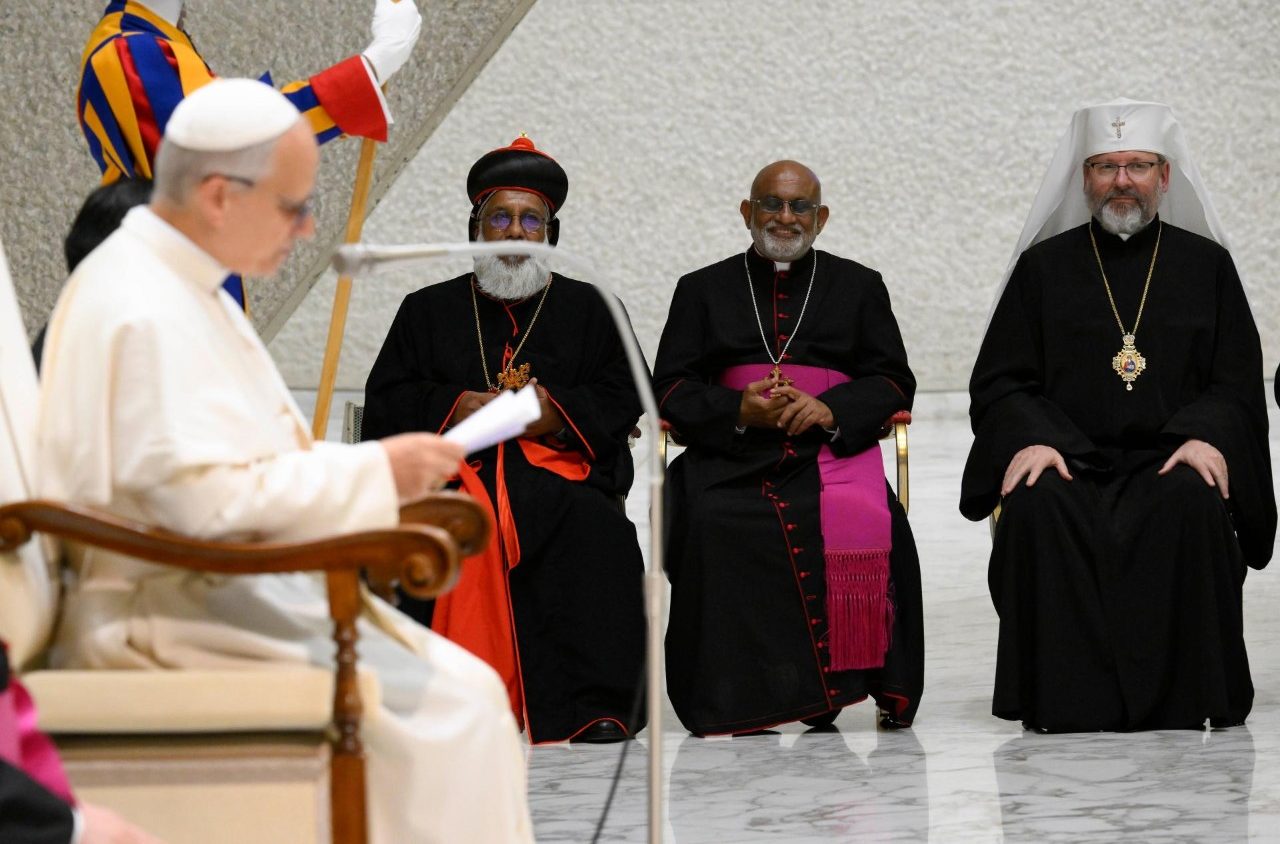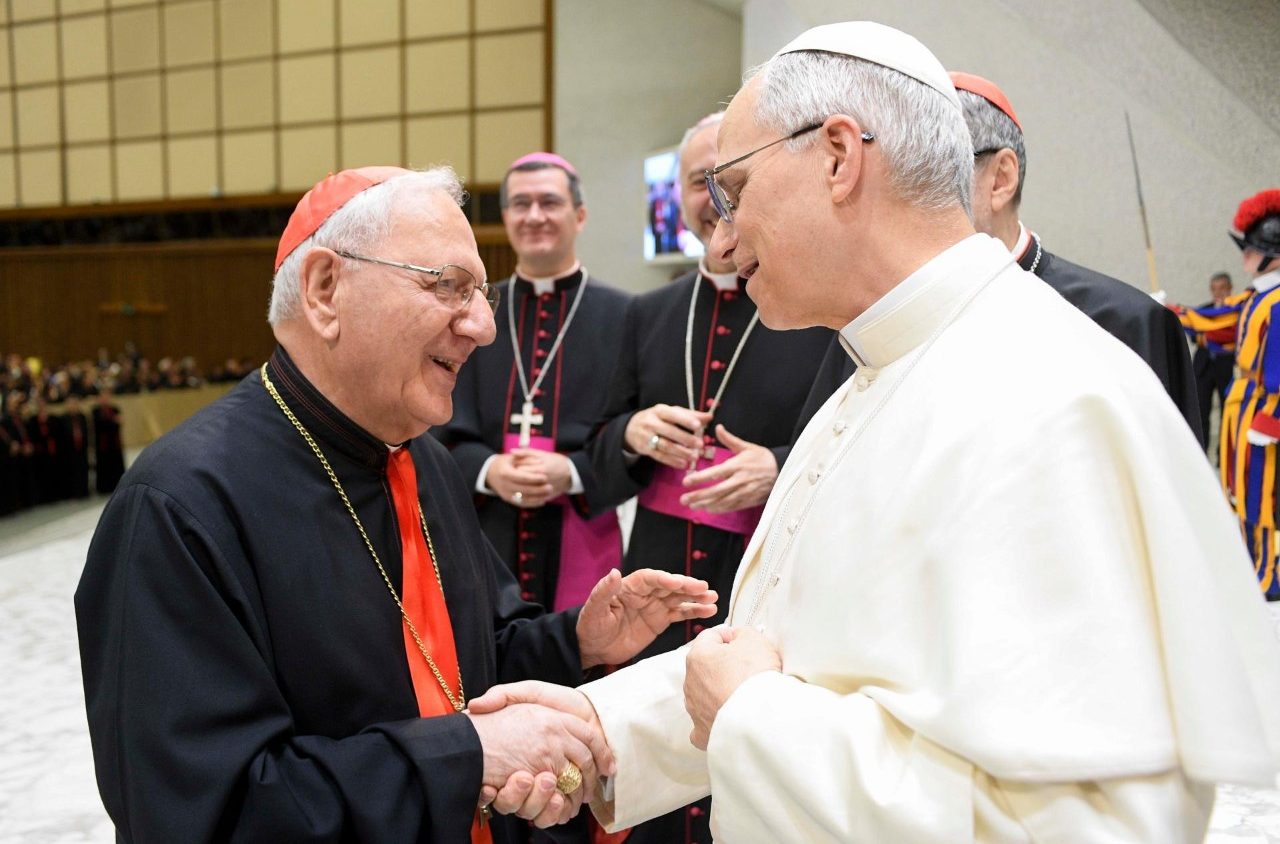🇪🇸 Leer en español
🇮🇹 Versione italiana
Vatican City – This morning, in the Paul VI Hall, one of the most significant general audiences of the new pontificate took place. The event marked a visible and symbolic return to the forma ecclesiae and to that institutional sobrietywhich has always distinguished the Petrine ministry: standing beside the Pope, in accordance with traditional practice, were the Regent of the Prefecture of the Papal Household, Monsignor Leonardo Sapienza, R.C.I., and — for the first time in twelve years — also the Private Secretary of His Holiness, Reverend Don Edgard Iván Rimaycuna Inga.
The presence of the Private Secretary next to the Pope represents a shift not only in form but one of deep substance. For too long, this figure had been reduced to the role of a mere “appointment diary”, without valid justification, leaving the Pontiff without a discreet yet decisive aide, vulnerable to informal circles and opaque influences. Don Edgard Iván, a Peruvian priest from the Diocese of Chiclayo, served for many years as a faithful collaborator to Cardinal Robert Francis Prevost, and now, as Prevost has become Pope, he continues to be supported by someone who knows him, supports him, protects him and serves him with competence and devotion.
At present, it is the Regent who carries out the functions of assisting the Pope in place of the Prefect of the Papal Household, a role currently vacant. There is no doubt that Leo XIV will be able to identify a worthy figure, rewarding those who have demonstrated over time their competence, dedication, and love both for the Pope and for the Institution. Already in the early signs of the pontificate, a restoration of ecclesial sobriety is evident: during the audience granted to journalists, and even more clearly today, the practice has been reinstated whereby only clericssurround the Holy Father during official appearances.
This is a theologically significant choice, consistent with the sacramental nature of the Petrine ministry, as the Pope himself reminded the faithful during his first Regina Caeli: each person in the Church serves according to his or her own state.

The Return of a Liturgy of the Heart
The setting of the audience was not merely institutional. It intertwined with a moment of great spiritual intensity: the conclusion of the Jubilee of the Eastern Churches, celebrated from 12 to 14 May. The Holy Father chose to address them in one of his first official speeches, highlighting the inestimable value of these ancient communities, which, despite their sufferings, faithfully preserve the richness of liturgy, synodality, and Christian spirituality. The Pope greeted the patriarchs and representatives of the Eastern Churches with the traditional Paschal proclamation: Christ is risen! He is truly risen!, touching the hearts of many present. He then continued: “You are precious! You preserve unique spiritual and sapiential traditions. Your liturgies, your ancient languages, your gestures still speak powerfully to the heart of the Church today.”
In a passage of great theological depth, he cited Pope Leo XIII and his apostolic letter Orientalium Dignitas (1894), stating that “the Catholic Church does not possess only one rite, but embraces all the ancient rites of Christianity” and that unity is not expressed through uniformity, but in variety, enlivened by common faith.
A Mission of Peace
The discourse then became prophetic and dramatic. The Pontiff made a heartfelt appeal to the leaders of nations at war, particularly in the Middle East, the Caucasus, and Ukraine: “War is never inevitable. Weapons do not solve problems — they multiply them. […] The peace of Christ is not the silence that follows destruction, but the gift that regenerates life and restores dignity to peoples.”
He then launched an appeal that clearly reflects his splendid approach to living the Petrine ministry: “In the name of military conquest, it is people who die. What emerges is an appeal — not so much that of the Pope, but of Christ, who repeats: ‘Peace be with you,’ and specifies, ‘I leave you peace, I give you my peace, not as the world gives it, do I give it to you.’”
Just as he advised in his first homily during the Holy Mass in the Sistine Chapel with the cardinals, Leo XIV wishes to become transparent and to make Jesus Christ shine forth. It is He, therefore, who calls for peace — the only source of true peace — not merely the Pope.
With words inspired by Saint Ephrem the Syrian and Saint Isaac of Nineveh, the Pope urged the faithful “not to lose the certainty of Easter amid life’s hardships”, and he invoked a new season of reconciliation, in which the Eastern Churches, grounded in their mystical and ascetic tradition, can offer the world a language capable of regenerating hope.

The Memory of the Election
Today’s atmosphere also recalled the intense moments of the recent conclave. At the end of the audience, Patriarch Louis Raphaël I Sako greeted the Pope with affection and emotion. It was he, together with Cardinal Tagle, who supported Cardinal Prevost during the voting in the Sistine Chapel. During the decisive moment of the scrutiny, Tagle offered a sweet to the future Pope, who accepted it with gratitude — a simple and human gesture. As his name increasingly became a litany within the Sistine Chapel, beneath Michelangelo’s Last Judgment, “Prevost took deep breaths”, and when the count reached 89 votes, his brother cardinals stood and offered a lengthy applause. Prevost, however, remained seated, head in hands. “Moreover, his name continued to be pronounced for a while longer,”explained one cardinal, suggesting that he was ultimately elected by around one hundred cardinals.
Today’s audience, beyond being the first truly distinctive moment of the Pontificate (whereas the one with journalists is now customary after each election), offered a beautiful glimpse into the richness of the Church. “We felt at home, loved by the Pope,” reported one patriarch to Silere non possum upon leaving the Paul VI Hall.
p.E.R.
Silere non possum